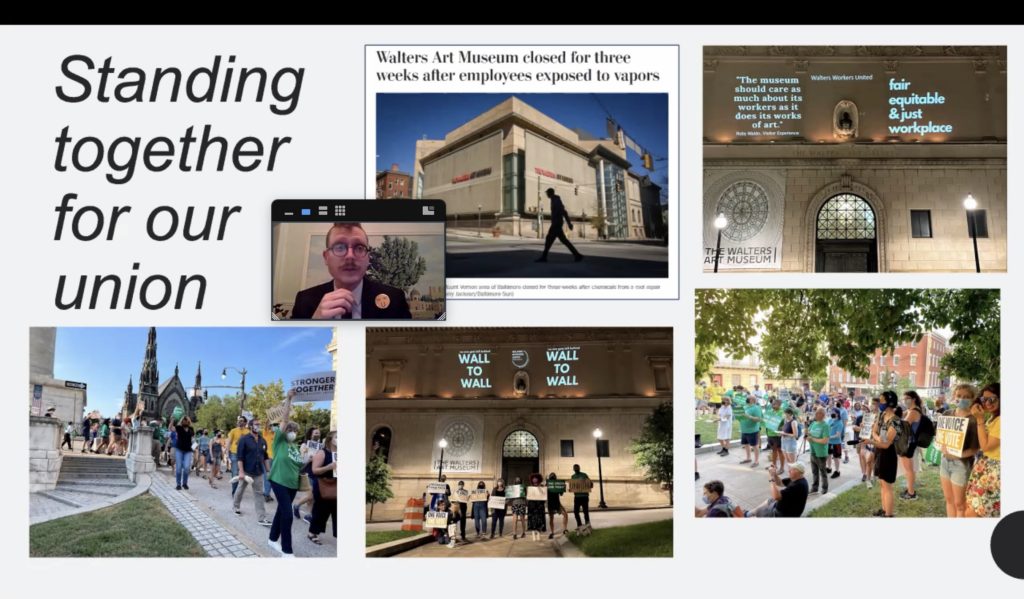With Walters Workers United members:
- Gregory Bailey, Senior Objects Conservator
- Karen French, Senior Paintings Conservator
- Will Hays, Associate Registrar
- Sam Mera-Candedo, Exhibition Designer (not present)
And The Baltimore Museum of Art Union Members:
- Mary Anne Arntzen, Conservation Technician for Objects and Textiles
- Sarah Cho, Curatorial Assistant in American Paintings, Sculpture, and Decorative Arts
- Lauren Ross, Conservator of Frames
At the beginning of November 2021, WCG had the opportunity to meet virtually with representatives of the unionizing parties at the Walters Art Museum and the Baltimore Museum of Art. We were joined by 73 guests from both local and ‘visiting’ institutions. The attendees included participants from museum backgrounds and from supportive unions outside of the cultural heritage sphere. The meeting began with a brief 20-minute presentation about the inception and progress of Walters Workers United (WWU), followed by a panel discussion and Q&A. Representing WWU were Senior Objects Conservator Greg Bailey, Senior Paintings Conservator Karen French, and Associate Registrar Will Hays. From the Baltimore Museum of Art, we were joined by Conservation Technician for Objects and Textiles Mary Anne Arntzen, Curatorial Assistant in American Paintings, Sculpture, and Decorative Arts Sarah Cho, and Associate Conservator of Frames Lauren Ross.

Organization of The WWU began during the COVID-19 pandemic, in a time when virtual communication led to an increase in cross-departmental conversations. Through open discussion, Walters employees identified and called for responses to several issues. The Education department called for improved accessibility, equity and inclusion, and the department of Safety and Security advocated for a greater voice in decisions of health and safety. Ultimately, employees across the museum were not satisfied with the museum administration’s response or often lack thereof.
In an effort to improve the Walters Art Museum and achieve its mission statement of inclusivity and transformation, employees formed the Walters Workers United. WWU went public on April 30, 2021 with their intentions to unionize with American Federation of State, County and Municipal Employees (AFSCME) Council 67.
The goal of WWU is to form a wall-to-wall union, which would allow all eligible workers across departmental boundaries to be covered by the same contract. This type of union is especially important for a smaller institution, such as the Walters (with only approximately 90-100 employees who would qualify to join the union), where breaking up the departments would result in a series of smaller and weaker groups. Further, by dividing the departments, there is an increased risk of perpetuating unequal treatment. In unionizing, WWU seeks pay equity, a fair and living minimum wage, access to benefits such as paid time off and healthcare, a voice in health and safety, and increased transparency in communication.
WWU has been met with overwhelming support from both colleagues and the community. While the executive director and CEO of the Walters Art Museum, Julia Marciari-Alexander, initially pledged to remain neutral in unionization efforts, WWU has faced resistance from the onset. Early in the process, the administration hired Shawe Rosenthal LLP, a law firm known for its committed anti-union stance.
There are multiple ways for a union to be recognized. To officially and democratically decide if employees want to form a union, an election must be held. The election may be arbitrated and certified by either the National Labor Relations Board (NLRB), a neutral third party, or by a municipal or governmental body.
The choice to unionize with AFSCME, the largest union in North America, was made based on several criteria, including the organization’s familiarity with cultural institutions through its subsidiary organization, Cultural Workers United. To allow all eligible workers to vote on joining one single union, WWU must hold an election either through a neutral third party or through the City of Baltimore. To pursue unionization through the city, it was necessary for representatives of WWU to call for the introduction of a bill by the city council to hold a hearing. In this hearing, WWU received overwhelming support by council members to facilitate Walters’ employees unionizing through a neutral third party or possibly through the city.
Julia Marciari-Alexander argues that the city council does not have jurisdiction in this situation, claiming that the Walters is a private entity, despite the fact that Walters is a government instrumentality created by state statute as an agent of the Mayor and City Council of Baltimore. Because of Julia Marciari-Alexander’s stance that the Walters is a private entity, she contends that any unionization of Walters employees must occur through the National Labor Relations Board, which covers private entities. Organizing efforts through the NLRB would preclude the formation of a wall-to-wall union, excluding security staff. AFSCME lawyers assert that the Walters Art Museum’s relationship with the city of Baltimore would prohibit unionization through the NLRB. Julia Marciari-Alexander has repeatedly refused requests to meet with the Walters Workers United or with a third party.
The Baltimore Museum of Art Union went public with their intention to unionize with AFSCME Council 67 in September 2021. The BMA Union approached their director requesting voluntary recognition, with over 51% of eligible members having signed union cards but were denied. Also seeking a wall-to-wall union through AFSCME Council 67, the BMA union will be pursuing an election through the city.
In hearing from our guest panelists, their passion was palpable. While the need for a union may come from a number of opaque or unsafe circumstances, the desire to unionize does not necessarily come from a place of resentment. It is clear that our friends at the Walters Art Museum and The Baltimore Museum of Art are dedicated to improving the future of their institutions. The drive to unionize, for these two groups, comes from a transparent and heartfelt desire to build a stronger workforce.
Summary by Jen Mikes, Graduate Intern in Objects Conservation at the Walters Art Museum, SUNY Buffalo State College Class of 2022